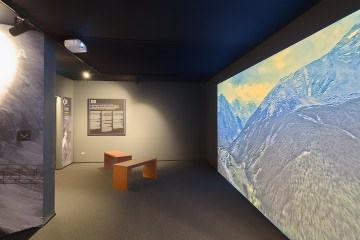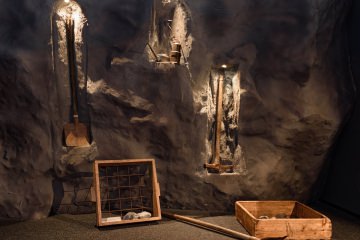CENTRO ESPOSITIVO PARCO MINERARIO VALLE D’AOSTA E DELLA MINIERA DI COGNE
The history of mining in the Aosta Valley to obtain raw material from the surrounding mountains dates back to ancient times, probably during prehistory.
The oldest written documents belong to the period of the roman conquest, and describe the tribes that occupied the region before the foundation of Augusta Praetoria (Aosta) in 25 B.C.. It appears that around the fourth century B.C. the tribe of Salassians, a celtic-ligurian people, melted copper. In his chronicles, the geographer Strabone in 1 B.C. wrote that this tribe, controlling the main roads crossing the Alps, imposed a toll to local guides and travellers, as they claimed to own mytical gold mines in the Alps. Afterwards, the Romans exploited the copper ore deposits of Saint-Marcel.
In the Middle Ages, the Aosta Valley and its mines were under the control of the Church and feudal lords, until the occupation of the House of Savoy.
The lack of adequate techniques, the sparse population and the high altitude of these mines didn’t allow proper use of these resources, except for the coal deposits of La Thuille. A modern mining activity was possible only at the end of XIX century when foreign entrepreneurs and engineers started to be involved in the development of the region.
The First World War highlighted the strategic importance of mines located in the heart of the Alps. The peak of production was reached in the middle of the XX century. Afterwards, when globalization started to take place, the high extraction cost was no longer competitive with imported minerals. This led to the end of the mining activities in the Aosta Valley in 1979.
It is important to point out that mining had been for a long time an important source of income for local people, even though this was a very hard and dangerous work for the miners.
There are several relics of this period, consisting of mines, tunnels, cableways to transport material and workers, and miners’ villages. Gathering all these witnesses of the past and delivering them to everyone is our responsibility, in order to make everybody aware of the mining activities and the working conditions of the miners. This is also a sign of our gratitude to our ancestors. We think, indeed, that knowing the past is the best way to live the present and to plan for the future.
This modern and interactive museum shows an overview of the timeline and places where the minerals were found (Brusson, Cogne, La Thuile, Ollomont, Saint-Marcel). You can experience life in a mine, looking at work places, understanding the difficulty of tunnel operations and the journey of the extracted material to Aosta, where it was further processed and transformed.
The museum is located in two separate buildings in the miners’ village: in the main square of the village, and in the cableway's arrival building.
The museum exhibition uses multimedia tools, to show not only the minerals but also the history of these places and the life of people. The visitor becomes a miner for one day. Interactive simulations allow him/her to use miners pickaxes, jackhammers, fill the carriages of the Drinc train and simulate a 3-D explosion in the mine.
Visiting hours:
9.30-12.00 and 15.00-18.00
Attention: open on Tuesday 5th and closed on Thursday 7th September
Closed on Tuesday
From the week of September 11th to October 31st
Open Friday, Saturday and Sunday
Closed in November
Open from 7 December to 7 January
Prices:
Full ticket : 10,00€
Discounts for children under 14, over 65, Amico di Cogne Card and groups: 8,00€
Aosta Valley Card: 5,00€
Free entry for disables and children under 4
- Visit the mines and museum
Full ticket: 27,00€
Reduced ticket: 20,00€
- Visit the museum and Maison Gerard Daynè
Full ticket: 13,00€
Reduced ticket: 10,00€
Where we are:
Exposition Center of the mining park and Cogne mine in the village of Cogne, Villaggio Minatori 85 (Villaggio Anselmetti) along the old road to Gimillan.












